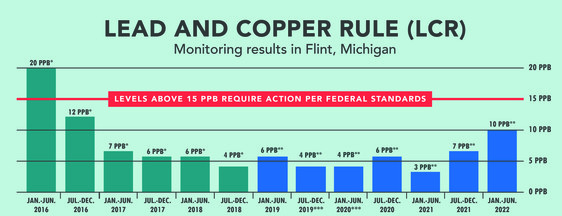|
FOR IMMEDIATE RELEASE
July 22, 2022
EGLE Media Office, [email protected], 517-284-9278
Flint maintains compliance with lead standards during major water infrastructure upgrades
As lead line replacement for homes nears completion testing at non-residential sites increases
The Michigan Department of Environment, Great Lakes, and Energy (EGLE) today announced that the City of Flint?s water system successfully maintained compliance with the state?s Lead and Copper Rule (LCR) during the past year?s multimillion-dollar project to modernize the city?s drinking water system.? Flint is now in its sixth year of meeting strict state and federal standards for lead in drinking water.
Since July 2016, the city of Flint?s water system has tested below action levels (LCR) during 12 consecutive monitoring periods. The latest six-month monitoring period from January 1 through June 30, 2022, shows that the 90th percentile calculation for the samples collected is at 10 parts per billion (ppb) for lead under the stricter state rule that requires a fifth liter sample to better reflect the impact of lead service lines. ?
The 90th percentile calculation of 10 ppb means 90 percent of the test results used in the calculation came in at or below 10 ppb.
The latest testing result is higher than the previous 6-month period result, but still below the federal action level of 15 ppb.? The change is attributed to the increase in non-residential (Tier 2) sites being added to the city?s sampling pool as the vast majority of residential (Tier 1) sites have had their lead service lines replaced and no longer meet the criteria for inclusion in the 90th percentile calculation.
Flint has conducted excavations to determine service line material composition at approximately 95 percent of the residential locations. City officials urge any remaining water customers who may potentially have lead service lines to opt into the city?s free replacement program.
The latest test results were calculated from drinking water samples drawn from 61 homes and businesses known to have lead service lines. 40 of these sites were single-family homes and other 21 were businesses. If only Tier 1 residential sites had been used the 90th percentile result would have been 7ppb. If only Tier 2 sites had been used in the calculation the 90th percentile would have been 14ppb.?
Many of the Tier 2 business sites sampled were converted homes with aging plumbing and lower water usage which can result in higher lead test results ? particularly from the first liter sample which is influenced by interior plumbing. If only the first liter sampling results were used, Flint?s 90th percentile result would have been 10 ppb in contrast to a 90th percentile? result of 4 ppb if only 5th liter sampling results were used.
?As Flint nears completion of its lead service line replacement program, we are seeing clear evidence that the focus will need to shift to interior plumbing and continued education on how to reduce lead exposures in the home as outlined on the state?s Mi Lead Safe web site,? said Kris Donaldson EGLE?s Clean Drinking Water Public Advocate.
Michigan in 2018 adopted the nation?s toughest lead rules for drinking water. The state?s Lead and Copper Rule (LCR) requires that all lead service lines in the state be removed. Water supplies are required to replace an average of five percent of their lead service lines every year for the next 20 years. Starting in 2025, the rule lowers the action level to 12 ppb.
Flint?s testing results can be found by visiting https://www.michigan.gov/flintwater/. Additional information about Michigan?s new testing requirements and results state-wide can be found at https://www.michigan.gov/mileadsafe/.

?
|
###
|